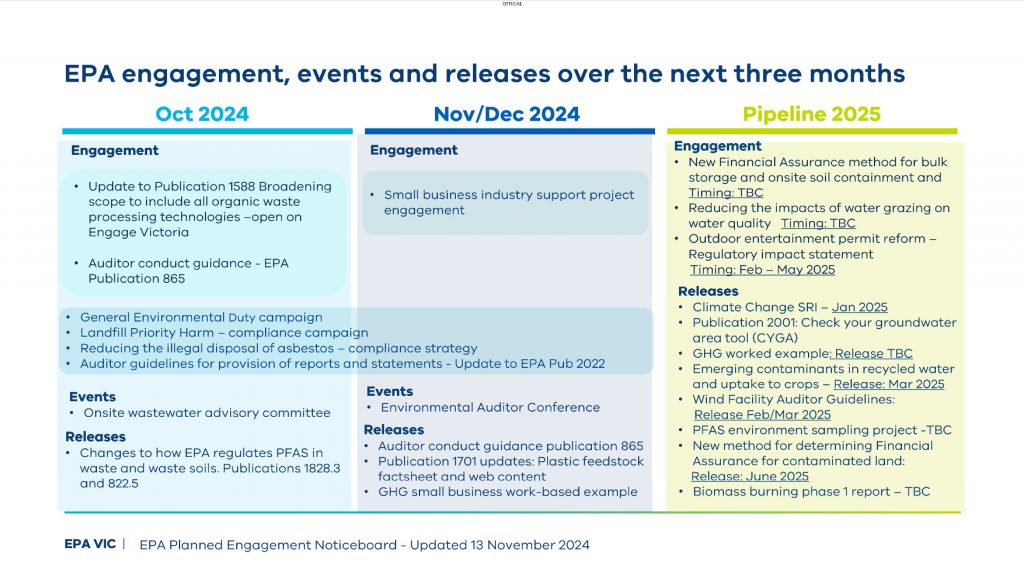EPA Resources, Energy and Extraction Sector Consultation Group
DR ELIZABETH GIBSON, General Manager CMPA reports on the Environment Protection Authority’s (EPA) Resources, Energy and Extraction Sector Consultation Group (RSCG).
Sector consultation groups were launched in late 2022.
They are EPA’s new approach to engaging with and sharing information between key sector groups across Victoria.
Purpose of Sector Consultation Groups
- To activate the principle of shared responsibility – that the protection of human health and the environment is a responsibility shared by all levels of government and industry, business, communities and the people of Victoria
- To drive continuous improvement in environmental performance through dialogue and consultation with members’ own networks of stakeholders operating within key sectors of the Victorian economy
- To bring together stakeholders and peer regulators to maximise the impact of Victoria’s Environment Protection Framework and manage strategic risks
- To actively support EPA to uplift the knowledge and capability of duty holders to comply with their environmental duties, particularly the General Environmental Duty/state of knowledge
- To support EPA in delivering environmental protection for the Victorian community, and
- To enable greater clarity, information and connectivity between EPA and its stakeholders.
RSCG Terms of Reference
• To work together to protect human health and the environment, in line with the principle of shared responsibility under Victoria’s environment protection framework.
• To support the resources, energy, and extraction sector to comply with obligations in the Environment Protection framework.
• To encourage higher performance across the sector in preventing and minimising risks of harm from waste and pollution.
• To provide a platform for consultation on EPA’s strategies, policies, and practices, in line with our Charter of Consultation.
Focus areas
The focus areas of the RSCG for the 2024-25 financial year are:
• Optimising co-regulation.
• • Theme – Alignment and collaboration of co-regulators
• Promotion of clarity and certainty of guidance and interpretation of EP Act.
• • Theme – Leveraging guidance, consistency between industry and regulator interpretation
• General Environmental Duty.
• • Theme – Promoting State of Knowledge and good practice
Member organisations
Australian Energy Council
Cement Concrete and Aggregates Australia
Chemistry Australia
Construction Material Processors Association
Department of Energy, Environment and Climate Action (Resources Victoria)
Minerals Council of Australia
Issues discussed at meeting held 21 November 2024
- Resources Victoria Approval Coordination (RVAC): An overview was presented and RVAC has been previously reported on in Sand & Stone.
- EPA – PFAS Thresholds for Classifying Waste and
Waste Soils
Changes to regulation of wastes containing PFAS
What are Per- and Polyfluoroalkyl substances (PFAS)?
• Large group of chemicals:
• long-lasting, persistent, bioaccumulative, mobile, and water-soluble
• Present in waste at landfills and wastewater treatment facilities
• EPA Focus:
• PFOS – Perfluorooctanesulfonic acid
• PFHxS – Perfluorohexanesulfonic acid
• PFOA – Perfluorooctanoic acid
Key Change
EPA has updated its approach to regulating wastes containing PFOS, PFHxS and PFOA, allowing duty holders to self-classify these wastes with precautionary thresholds to protect human health and the environment.
Previously, duty holders had to seek a designation for
everything other than fill material when PFOS, PFHxS and PFOA were detected.
To implement these changes, EPA has issued new versions
of two guidelines:
I. Publication 1828.3 Waste disposal categories – characteristics and thresholds: Now includes thresholds for three PFAS in tables 2 and 3 and is available from https://www.epa.vic.gov.au/about-epa/publications/1828-3-waste-disposal-categories
II. Publication 822.5 Waste Codes: (https://www.epa.vic.gov.au/about-epa/publications/iwrg822-5). Now includes a contaminant code for PFAS, which is deployed in Waste Tracker.
What has EPA changed?
• Thresholds for PFOS, PFHxS and PFOA in Publication 1828.3
• Moves from permissions to self-classification of these PFAS for all categories of waste
• Lower category D limits for soil waste containing PFAS
• New contaminant code for PFAS to support better reporting of PFAS impacted wastes and allow tracking through Waste Tracker
What has not changed?
• Thresholds for Categories C, B and fill
• PFAS other than PFOS, PFHxS and PFOA will still need a specific designation
• Duty holders can still apply for a specific designation to classify their waste if desired
• No changes to the fill material determination
• No change to how landfills are regulated and operate
• Fill material with PFOS, PFHxS and PFOA will continue to be industrial waste (no tracking required)
- EPA’s planned engagement noticeboard

If any CMPA Member would like to have an issue raised with EPA in the RSCG, please contact [email protected].









You must be logged in to post a comment Login